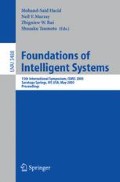Abstract
We survey some of the approaches to dialogue representation and processing for modern telephone answering systems. We include discussions of their strong and weak points and some of the performance levels obtained by them.
Access this chapter
Tax calculation will be finalised at checkout
Purchases are for personal use only
Preview
Unable to display preview. Download preview PDF.
References
Rudnicky, A., Hauptmann, A., Lee, K.F.: Survey of current speech technology. Communications of the ACM 37, 52–57 (1994)
van Kuppevelt, J., Smith, R.W. (eds.): Current and New Directions in Discourse and Dialogue. Kluwer Academic Publishers, Dordrecht (2003)
Walker, M.A., Hirschman, L., Aberdeen, J.: Evaluation for darpa communicator spoken dialogue systems. In: Proceedings of the Second International Conference on Language Resources and Evaluation, Athens, Greece (2000)
Levin, E., Narayanan, S., Pieraccini, R., Biatov, K., Bocchieri, E., Fabbrizio, G.D., Eckert, W., Lee, S., Pokrovsky, A., Rahim, M., Ruscitti, P., Walker, M.: The at&t-darpa communicator mixed initiative spoken dialog system. In: Proceedings of the International Conference on Spoken Language Processing, ICSLP 2000 (2000)
Levin, E., Pieraccini, R., Eckert, W.: A stochastic model of human-machine interaction for learning dialog strategies. IEEE Transactions on Speech and Audio Processing, 11–23 (2000)
Rudnicky, A., Bennett, C., Black, A., Chotomongcol, A., Lenzo, K., Oh, A., Singh, R.: Task and domain specific modelling in the carnegie mellon communicator system. In: Proceedings of the International Conference on Spoken Language Processing, ICSLP 2000 (2000)
Rudnicky, A., Xu, W.: An agenda-based dialog management architecture for spoken language systems. In: IEEE Automatic Speech Recognition and Understanding Workshop (1999)
Smith, R.W., Hipp, D.R.: Spoken Natural Language Dialog Systems. Oxford University Press, New York (1994)
Cohen, P.: Models of dialogue. In: Proceedings of the Fourth NEC Research Symposium (1994)
Hardy, H., Biermann, A., Inouye, R., McKenzie, A., Strzalkowski, T., Ursu, C., Webb, N., Wu, M.: Data-driven strategies for an automated dialogue system. In: Proceedings of the 42nd Annual Meeting of the Association for Computational Linguistics (2004)
Allen, J., Perrault, C.: Analyzing intention in utterances. Artificial Intelligence 15, 143–178 (1980)
Litman, D., Allen, J.: A plan recognition model for subdialogs in conversations. Cognitive Science 11, 163–200 (1987)
Smith, R.W., Hipp, D.R., Biermann, A.W.: An architecture for voice dialog systems based on prolog-style theorem proving. Computational Linguistics 21, 281–320 (1995)
Fikes, R., Nilsson, N.: Strips: A new approach to the application of theorem proving to problem solving. Artificial Intelligence 2, 189–208 (1971)
Guinn, C.: Mechanisms for mixed-initiative human-computer collaborative discourse. In: Proceedings of the 34th Annual Meeting of the Association for Computational Linguistics (1996)
Guinn, C.I.: Meta-Dialogue Behaviors: Improving the Efficiency of Human-Machine Dialogue. PhD thesis, Duke University (1994)
Inouye, R.B.: Minimizing the length of non-mixed initiative dialogs. In: Companion Volume to the Proceedings of the Association for Computational Linguistics, pp. 13–18 (2004)
Baker, K., McKenzie, A., Biermann, A., Webelhuth, G.: Constraining user response via multimodal interface. International Journal of Speech Technology 7, 251–258 (2004)
Chu-Carroll, J., Carpenter, B.: Vector-based natural language call routing. Computational Linguistics 25, 361–388 (1999)
Author information
Authors and Affiliations
Editor information
Editors and Affiliations
Rights and permissions
Copyright information
© 2005 Springer-Verlag Berlin Heidelberg
About this paper
Cite this paper
Biermann, A.W., Inouye, R.B., McKenzie, A. (2005). Methodologies for Automated Telephone Answering. In: Hacid, MS., Murray, N.V., Raś, Z.W., Tsumoto, S. (eds) Foundations of Intelligent Systems. ISMIS 2005. Lecture Notes in Computer Science(), vol 3488. Springer, Berlin, Heidelberg. https://doi.org/10.1007/11425274_1
Download citation
DOI: https://doi.org/10.1007/11425274_1
Publisher Name: Springer, Berlin, Heidelberg
Print ISBN: 978-3-540-25878-0
Online ISBN: 978-3-540-31949-8
eBook Packages: Computer ScienceComputer Science (R0)

